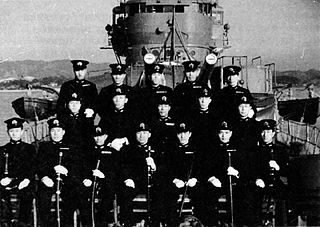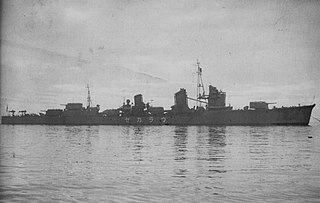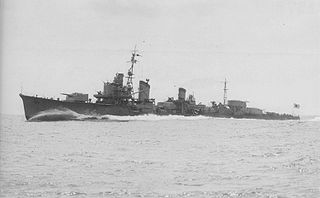
Akigumo(秋雲, "Autumn Clouds") was one of 19 Kagerō-class destroyers built for the Imperial Japanese Navy during the 1930s.

Urakaze(浦風, "Wind on the Sea") was one of 19 Kagerō-class destroyers built for the Imperial Japanese Navy during the 1930s.

Makinami(巻波) was a Yūgumo-class destroyer of the Imperial Japanese Navy. Her name means "Overflowing Waves".

Takanami (高波) was a Yūgumo-class destroyer of the Imperial Japanese Navy. Her name means "Tall Wave".

Tamanami was a Yūgumo-class destroyer of the Imperial Japanese Navy.

Suzunami was a Yūgumo-class destroyer of the Imperial Japanese Navy.

Kishinami was a Yūgumo-class destroyer of the Imperial Japanese Navy.

Hayanami was a Yūgumo-class destroyer of the Imperial Japanese Navy.

The Derzky or Bespokoiny-class destroyers was a class of destroyers built for the Imperial Russian Navy just before World War I. Nine ships were built for the Black Sea Fleet. These ships were a derivative of the Russian destroyer Novik, but were slightly smaller. These ships were popular with the Russians and effective particularly in the Black Sea, where the Ottoman Navy had no similar ships.

The Orfey-class destroyers were built for the Baltic Fleet of the Imperial Russian Navy. They were modified versions of the earlier destroyer Novik and the Derzky-class destroyers. These ships were larger, had triple torpedo tubes and an extra 102 mm (4 in) gun. One ship, Engels, was fitted with a 305 mm (12 in) recoilless rifle for testing in 1934. Fourteen ships were completed in 1914–1917 and fought in World War I and during the Allied intervention in the Russian Civil War. The survivors fought in World War II.
The Izyaslav class were a class of destroyers built for the Baltic Fleet of the Imperial Russian Navy. They were modified versions of the Orfey class built in Russia with the assistance of the French company Augustin Normand. These ships fought in World War I, the Russian Civil War, the Estonian War of Independence, and World War II.

Matsuwa (松輪) was one of fourteen Etorofu-class escort ships built for the Imperial Japanese Navy during World War II.

Hatsuzakura was one of 23 escort destroyers of the Tachibana sub-class of the Matsu class built for the Imperial Japanese Navy during the final stages of World War II. The ship was used to repatriate Japanese personnel after the war until 1947. Mid-year the destroyer was turned over to the Soviet Union and was commissioned that same year. She was renamed Vyrazitelny later that year. When the ship was converted into a target ship in 1949, she was renamed TsL-26. The vessel was ordered to be scrapped a decade later.
Karl Marx was the lead ship of her class of five destroyers built for the Russian Imperial Navy during the 1910s. Completed during 1916, she served with the Baltic Fleet during the remainder of the First World War, and after the October Revolution joined the Bolshevik Red Fleet. She was active during the Russian Civil War, taking part in several engagements against British ships during the British campaign in the Baltic. The destroyer was renamed Karl Marx in 1922. She played a small role in the Winter War with the Soviet Baltic Fleet when Germany invaded the Soviet Union in 1941, and was sunk by German aircraft on 8 August 1941.
Kalinin was one of five Izyaslav-class destroyers ordered for the Russian Imperial Navy during the 1910s. Not completed during the First World War, she was finally finished by the Soviets in 1927. She played a small role in the Winter War with the Baltic Fleet when Germany invaded the Soviet Union in 1941, and was sunk by naval mines on 28 August 1941.

Samson was one of eight Orfey-class destroyers built for the Russian Imperial Navy during World War I. Completed in 1916, she served with the Baltic Fleet and joined the Bolshevik Red Fleet after the October Revolution of 1918. She was active during the Russian Civil War, taking part in several engagements against British ships during the British campaign in the Baltic. The destroyer was renamed Stalin in 1922. She was assigned to the Pacific Fleet when Germany invaded the Soviet Union in 1941 and saw little to no combat. The ship was scrapped in 1953.

Desna was one of eight Orfey-class destroyers built for the Russian Imperial Navy during World War I. Completed in 1916, she served with the Baltic Fleet and joined the Bolshevik Red Fleet after the October Revolution of 1918. She was active during the Russian Civil War, taking part in several engagements against British ships during the British campaign in the Baltic. The destroyer was renamed Engels in 1922. She remained in service with the Soviet Baltic Fleet when Germany invaded the Soviet Union in 1941, and was sunk on 24 August.

Pobeditel was one of eight Orfey-class destroyers built for the Russian Imperial Navy during World War I. Completed in 1915, she served with the Baltic Fleet and joined the Bolshevik Red Fleet after the October Revolution of 1918. She was active during the Russian Civil War, taking part in several engagements against British ships during the British campaign in the Baltic. The destroyer was renamed Volodarski in 1922. She remained in service with the Soviet Baltic Fleet when Germany invaded the Soviet Union in 1941, and was sunk on 28 August.

Zabiyaka was one of eight Orfey-class destroyers built for the Russian Imperial Navy during World War I. Completed in 1916, she served with the Baltic Fleet and joined the Bolshevik Red Fleet after the October Revolution of 1918. She was active during the Russian Civil War, taking part in several engagements against British ships during the British campaign in the Baltic. The destroyer was renamed Uritski in 1922. She was assigned to the Baltic Fleet when Germany invaded the Soviet Union in 1941, and survived the war to be scrapped in 1953.
This page is based on this
Wikipedia article Text is available under the
CC BY-SA 4.0 license; additional terms may apply.
Images, videos and audio are available under their respective licenses.








